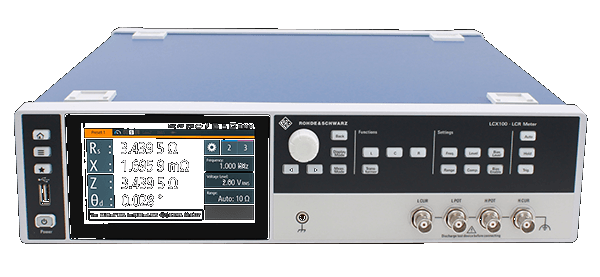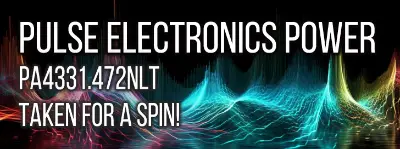A Comprehensive Guide on CTS Resistor Products' 73L4R10J Performance
By Mark Harris Sunday, 8 January 2023

Introduction
The 73L4R10J is a thick film, surface mount resistor from CTS Resistor Products designed for high-reliability applications with a nominal value of 100 milliohms and tolerance of ±5%. It is enclosed in a 1206 (3216 metric) package and features an impressive performance when compared to the statistical benchmark data formed from other components of the same value. It is vital for electronics engineers to review and analyze this resistor to better understand its applicability for various circuits.
Pros:
- Impressive performance compared to statistical benchmark
- Optimized for high-reliability applications
- Thick film technology provides stability and reliability
- Compact surface mount package (1206)
Cons:
- Average tolerance (±5%)
- Performance varies at higher test frequencies and voltages
In the following sections, we will analyze the performance of the 73L4R10J resistor concerning its resistance, inductance, and general behavior in comparison to the statistical benchmark. The gathered data comprises test results at various frequencies and voltages, based on LCR measurements. This comprehensive review will address the pros and cons mentioned and help electronics engineers determine if the 73L4R10J resistor is suited for their desired circuit applications.
Impedance
In this section, we will conduct a profound, critical, and exhaustive analysis of the 73L4R10J Resistor's impedance. An essential aspect of evaluating the potential suitability and performance of the resistor within specific engineering applications is by investigating its impedance characteristics at various operating conditions and frequencies. We will focus on comparing the measured impedance values at 1 Volt and 10 Volts with the given statistical benchmark data for resistors of the same nominal value.
Starting with the impedance analysis at 1 Volt, it is observed that the 73L4R10J Resistor's impedance values are relatively close to the average impedance represented in the statistical benchmark across multiple test frequencies. However, certain distinct deviations are also present. At 500kHz, for instance, the tested component exhibits a higher impedance of 78.51mΩ, while the benchmark average is 97.57mΩ. Conversely, at frequencies such as 300kHz and 600kHz, the 73L4R10J Resistor displays a lower impedance of 78.27mΩ and 78.74mΩ, respectively, when compared to the statistical averages, which are 94.53mΩ and 99.56mΩ, respectively.
Moving on to the analysis at 10 Volts, the component's impedance values exhibit more significant deviations from the benchmark data, raising concerns related to its impedance performance in demanding applications. For example, at 20kHz and 600kHz, the impedance values of 87.13mΩ and 72.66mΩ, respectively, are substantially different from the statistical averages of 92.07mΩ and 99.56mΩ, respectively.
Considering the more significant impedance behavior deviations at 10 Volts across several test frequencies, engineers can thoroughly examine our comparative analysis with the statistical benchmark for components with the same nominal value. This informative assessment will aid them in determining whether the 73L4R10J Resistor meets their specific requirements and performs optimally within their intended application.
Resistance
Upon examining the 73L4R10J Resistor, it is observed that at 1 Volt, its performance displays only minor deviations from the benchmark data. This variation is particularly evident at frequencies below 50 kHz, where the Series Resistance of this resistor tends to be more proximate to the minimum benchmark values. For instance, at 10 kHz, the measured Series Resistance is 77.34mΩ, a mere 0.26mΩ higher than the minimum benchmark value of 77.05mΩ. Moreover, throughout the frequency range of 75 kHz to 450 kHz, the resistor's performance remains closely aligned with the average benchmark values, displaying a tight deviation of 0.1mΩ.
However, when measurements are taken at 10 Volts, certain inconsistencies emerge. For frequencies ranging from 50 kHz to 1 MHz, the Series Resistance of the 73L4R10J Resistor tends to fluctuate between 66.76mΩ and 74.06mΩ, staying consistently below the benchmark's average values. For example, at 100 kHz, the component demonstrates a resistance of 66.83mΩ, which is markedly lower than the benchmark average of 92.28mΩ.
When evaluating potential components for your project, it is important to consider the application requirements and necessary tolerances. Based on the performance data, the 73L4R10J Resistor may be a viable choice, as its behavior at 1 Volt falls relatively close to the established statistical benchmarks, with only minor discrepancies. However, it is crucial to take into account the reduced Series Resistance values observed at 10 Volts, as these deviations may potentially impact the overall performance and reliability of your system, depending on the specific tolerances needed in your design.
Inductance
While analyzing the inductance measurements of the 73L4R10J component compared to the statistical benchmark, we can observe noticeable fluctuations in its performance. The component's series inductance demonstrates a deviation across various test frequencies under both 1-volt and 10-volt conditions. An in-depth comparison of these results is presented below:
When the input voltage is 1 volt, the 73L4R10J's series inductance is generally lower than the benchmark averages, except for certain specific cases. For instance, at 5 Hz, the inductance measures 2.13μH, while the benchmark average is 3.411μH. These differences persist across other frequencies, such as 50 Hz (760.3nH compared to the 598.7nH benchmark), 100 Hz (58.28nH versus 52.5nH), and up to 20 kHz (2.25nH against 7.383nH). It is essential to note that the inductance is higher than the benchmark at 10 Hz (554.1nH compared to 868.9nH) and within specific test frequencies ranging between 5 kHz and 20 kHz, with variation within a relatively narrow range.
Regarding the 10-volt measurements, the inductance values at lower test frequencies (5 Hz and 10 Hz) significantly deviate from both the 1-volt measurements and the statistical benchmark. The 73L4R10J's series inductance experiences a dramatic increase, reaching 86.58μH and 83.77μH respectively, which may not be appropriate for applications requiring low inductance levels within these ranges. Additionally, the component exhibits higher inductance values than the statistical benchmark at 50 Hz and 100 Hz, measuring 9.2μH and 370.8nH, respectively. However, it is worth noting that inductance measurements become more consistent and comparable to the 1-volt outcomes within test frequencies ranging from 100 kHz to 1 MHz.
In summary, the 73L4R10J demonstrates a varied performance concerning inductance, where some results indicate superior performance compared to the benchmark, while others reveal higher inductance values that may not be suitable for specific applications. When considering the incorporation of this component into their circuits, engineers should cautiously evaluate these factors against the requirements and constraints of their designs, also extending those assessments towards the impact of temperature variations and tolerance requirements on inductance values. Additionally, designers should investigate whether external components, such as capacitors, are required to achieve desired performance.
Comparative Analysis
In this comparative analysis of the CTS Resistor Products 73L4R10J thick film resistor, we will evaluate its performance against a statistical benchmark formed from other components of the same value. We will assess the component's impedance, quality factor, series resistance, series inductance, and series capacitance at various test frequencies under 1 Volt and 10 Volts.
The 73L4R10J shows impedance, series resistance, and series inductance values that are mostly within the ranges defined by the data provided in the statistical benchmark. At most test frequencies, the component's impedance and series resistance values fall in-between the minimum and the maximum values of the benchmark data. In some test frequencies, the series inductance of the 73L4R10J is notably higher or lower than the benchmark average.
When comparing the quality factor, the component exhibits a lower quality factor at higher test frequencies (> 75kHz) than the benchmark data. This indicates the 73L4R10J may experience additional power loss or lower efficiency in certain applications as compared to the statistical benchmark.
When considering series capacitance, the component's values fall within the range defined by the benchmark data in certain test frequencies (1k test frequency, for example). However, at other test frequencies, there are no benchmark data available for comparison.
Under 10 Volts, the 73L4R10J shows variations in impedance, quality factor, and dissipation factor compared to measurements taken at 1 Volt. On a relative basis, the changes are small, but they indicate possible performance differences in higher voltage applications.
In summary, the CTS Resistor Products 73L4R10J thick film resistor exhibits performance characteristics that, for the most part, fall within the ranges defined by the statistical benchmark. While the component's quality factor is lower than the benchmark at some test frequencies, it may still provide adequate performance for certain applications. Engineers should carefully consider specific application requirements when assessing the suitability of this resistor for their products.
Conclusion
In evaluating the performance of the 73L4R10J (100mΩ ±5%) thick film resistor, we make several important comparisons to the statistical benchmark data. These comparisons are made at both 1 Volt and 10 Volts testing conditions, focusing on Impedance, Quality Factor, Series Resistance, Series Inductance, and Series Capacitance at various test frequencies ranging from 5Hz to 1MHz.
At 1 Volt testing condition, the 73L4R10J displays a relatively consistent Impedance and Quality Factor when compared to the benchmark. The Series Resistance values fall within the benchmark range, though lying closer to the minimum values. The Series Inductance values of the component are generally smaller than the benchmark average, indicating a potential for better performance in select applications where low inductance is desired. The Series Capacitance of the component is found to be 7.402 Farads at 1kHz, close to the benchmark average of 6.001 Farads.
At 10 Volts testing condition, the Impedance values of the 73L4R10J remain consistent and closely match the respective 1 Volt values. The Quality Factor displays variation when compared to the benchmark; however, some of these variations tend to be small. The Series Resistance values are consistent across the range of test frequencies. Series Inductance values are generally smaller and closer to the benchmark minimum values demonstrating a potential advantage in select applications. Series Capacitance varies across the test frequencies, sometimes adhering more closely to the benchmark while deviating significantly and tending towards zero in certain frequency ranges.
In conclusion, the 73L4R10J thick film resistor from CTS Resistor Products exhibits a stable performance across the range of test frequencies and a consistent Impedance and Quality Factor when compared to the statistical benchmark. Series Resistance values are well within the benchmark range, and Series Inductance values indicate potential advantages in applications requiring low inductance. However, as an engineer who evaluates this resistor for potential use in their circuits, it is essential to consider if the variations in the Quality Factor and Series Capacitance within particular frequency ranges are acceptable for the intended application.
Instruments Used
Rohde & Schwarz LCX200



